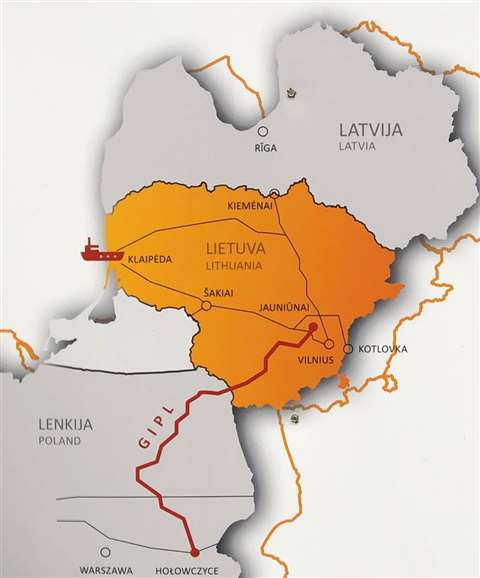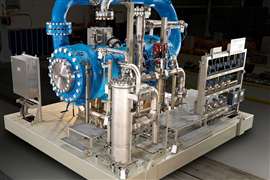Euro Gas Report: GIPL pipeline placed into service
May 23, 2022
 The European Commission said the project opens up new options for gas imported via the Klaipėda LNG terminal in Lithuania and the Świnoujście LNG Terminal in Poland.
The European Commission said the project opens up new options for gas imported via the Klaipėda LNG terminal in Lithuania and the Świnoujście LNG Terminal in Poland.
The Gas Interconnection Poland-Lithuania (GIPL) entered service on May 1 and was officially opened on May 5 with an inauguration ceremony at the Jauniūnai compressor station, where the pipeline begins on the Lithuanian side.
The partners in the project, Lithuania’s Amber Grid and Poland’s Gaz-System, said that the 508-km (316-mile) pipeline effectively expands the European gas market by integrating the Baltic countries and Finland into it.
In a separate announcement, the European Commission said the project strengthens the energy independence of the region and opens up new options for gas imported via the Klaipėda LNG terminal in Lithuania and the Świnoujście LNG Terminal in Poland.
The capacity for transporting gas from Lithuania to Poland is expected to ramp up to 67.1 bcf/y (1.9 ×109 m3/y) over the next five months while the capacity from Poland to Lithuania reaches 70.6 bcf/y (2.0 ×109 m3/y).
The start-up of the pipeline came days after Russia said it was suspending gas exports to Poland and Bulgaria over their refusal to pay for shipments in rubles. (See earlier story) Poland and Bulgaria are the only two European countries whose contracts with Russia’s Gazprom are expiring at the end of 2022, so they had already been searching for alternative sources of supply.
“The Russian invasion of Ukraine and the fact that the Russians have withheld gas transmission to Poland from the east have only confirmed that the decisions taken over six years ago by Gaz-System concerning the construction of new transmission infrastructure were well-justified and necessary,” stated Gaz-System’s president, Tomasz Stępień, in the announcement about the GIPL’s launch.
European Union
Payment for Russian gas approved
The European Union will allow buyers to pay for Russian gas without breaching sanctions against Moscow, under updated guidance from the European Commission, it has been reported.
The updated guidance is reported to have been shared with EU countries on May 13. Reuters reported that the Commission has confirmed its previous advice that EU sanctions do not prevent companies from opening an account at a designated bank and paying for Russian gas as long as they do so in the currency agreed in their existing contracts. They also need to declare any transaction as completed once payment has been made.
Nearly all of the contracts EU companies have with Russia’s Gazprom are in euros or dollars, though Russia has been demanding payments in rubles.
The European Commission’s latest guidance represents a loophole, as it allows companies to avoid dealing with the Russian central bank, which is under sanctions, by ending their obligations once they pay in euros or dollars. However, Moscow has said that transactions would only be seen as complete once these currencies have been converted into rubles, suggesting that there is considerable potential for further disputes over the issue.
The need for such loopholes illustrates how challenging it is for EU countries to wean themselves off Russian gas even as they step up efforts to secure alternative supplies. Concerns over potential disruption of Russian gas supplies to Europe have been heightened by recent developments, including the suspension of flows via one transit point in Ukraine. (See later story)
Additionally, Russia said that it would suspend gas shipments to Bulgaria and Poland over their refusal to pay for this gas in rubles. The EU condemned the decision as an “instrument of blackmail”.
ITALY
Azerbaijan talks up potential for TAP expansion
Azerbaijani President Ilham Aliev said that his country could double its gas supplies to Italy by expanding the capacity of the Trans Adriatic Pipeline (TAP).
Speaking at an international conference, Aliev said the pipeline’s capacity could be increased from 353.1 bcf/y (1 ×1010 m3/y) to 706.3 bcf/y (2 ×1010 m3/y) by installing additional compressor stations along its route. He said he had already discussed the idea of expanding the TAP with Italian Prime Minister Mario Draghi and Foreign Minister Luigi di Maggio. However, he warned that it would be up to the TAP consortium partners to decide on any new investments and that this was not a decision they could make quickly.
The pipeline’s infrastructure currently includes one compressor station near Kipoi, at the Greek border with Turkey, and another on the Albanian coast near Fier. Two additional compressor stations have been proposed for doubling the TAP’s capacity. A new one would be built near Serres in Greece while at Bilisht, on Albania’s side of the Albanian-Greek border, an existing metering station would be converted into a compressor station. The station would be fitted with additional turbo-compressors as part of the conversion.
According to Aliev, Azerbaijan has also received requests from other European countries besides Italy to increase gas shipments. However, he noted that Azerbaijan bases its export plans on specific volumes as set out in existing contracts.
UKRAINE
Ukraine suspends gas flows through Sokhranivka metering station
The Gas Transmission System Operator of Ukraine (GTSOU) announced on May 11 that it had suspended the transit of Russian gas through the Sokhranivka gas metering station. This came a day after the operator declared force majeure at both the metering station and the Novopskov compressor station, which are located on the border with Russia, in the breakaway region of Luhansk.
The GTSOU said that because the region was currently under Russian military occupation, it was unable have operational and technological control over the facilities. It has also accused the occupying forces of interfering in the operation of Ukraine’s gas transmission infrastructure in the region.
The Novopskov compressor station is used for the transit of up to 1.2 bcf/d (3.26 ×107 m3/d) of gas, which is almost a third of the Russian gas flowing to Europe according to the GTSOU. The operator has proposed shifting volumes from Sokhranivka entry point to the Sudzha entry point, but Russia’s Gazprom has said it would be technologically impossible to divert all of the volumes involved.
However, the GTSOU has rejected this claim, saying that transit through Sudzha was 2.5 bcf/d (7.2 ×107 m3/d) of gas as of May 11 but that the three pipelines that pass through the Sudzha metering station have a total technical combined capacity of 8.6 bcf/d (2.4 ×108 m3/d). It noted that average daily transit volumes through Sudzha had been considerably higher in recent years, adding that a similar transfer of capacity from Sokhranivka had taken place for part of October 2020 due to scheduled maintenance. During this maintenance period, gas transit through Sudzha was 5.8 bcf/d (1.7 ×108 m3/d).
UK
Neptune advances Cygnus gas compression project towards start-up
Neptune Energy has provided an update on its gas compression project at the Cygnus field in the UK North Sea in its first-quarter earnings call.
Company executives said on the call that the gas compression project would enter service in the second quarter, supporting production from the field. The system is currently undergoing testing. Two additional development wells are also due to be drilled at Cygnus, with Cygnus-10 expected online in October and the subsequent well in 2023.
The start of gas compression at the field is anticipated to result in a marginal increase in the carbon intensity of Neptune’s operated production to around 8 kg of carbon dioxide (CO2) per barrel, the company noted. However, it is also using the Cygnus platform as a case study for assessing the potential electrification of its offshore platforms in the North Sea. Neptune anticipates that the report, when it is published, will outline significant opportunities for reducing emissions, as well as highlighting commercial and regulatory challenges.
MAGAZINE
NEWSLETTER

CONNECT WITH THE TEAM








